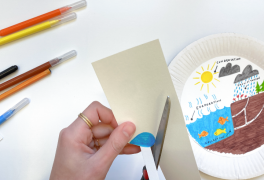
LET’S DO IT
The water cycle? Child's play!
It's never too early to get little ones thinking about protecting the planet! To mark World Water Day, or to keep you busy on a rainy day, we've come up with a few ideas to get your felt-tip pens fired up. So dust off your basics and become an environmental genius with this interactive diagram of the water cycle. Don't panic, it's not rocket science! ;) We won't hide the fact that it's likely to trigger a wave of " why ", but you're used to that!

Materials
- 1 white paper plate
- 1 sheet of canson paper
- 1 pair of scissors (for parents)
- 1 split pin
- Felt-tip pens
- Glue
- Good humour (don't use everything at first)

Instructions
Step 1: Drawing
Draw the 4 stages of the water cycle: evaporation, condensation, precipitation and collection. Depending on your child's age, you can draw the shapes for them to colour and separate the sections so that the result is easy to read. Tip: cut a circle of canson paper the size of the centre of the plate and stick it on for an even prettier design
Step 2: The water droplet shaped pointer
Draw a rectangle on the canson sheet to make the pointer and a droplet of water at the end to indicate the stage of the cycle we are at. Colour the droplet.
Step 3: Attaching the pointer
Pierce the end of the strip with the split pin, then insert it into the plate with a small hole in the centre (this step is carried out by the parents for added safety). Then close the clip on the back of the plate.

The result
Now all you have to do is turn the pointer to find out how far the water has travelled and explain each of the 4 stages in your own words! Simple is best!


Other ideas
Learning to save water on a daily basis is all about good habits! Teeth brushing can be done for the length of a nursery rhyme, or with an hourglass to teach the correct length of time (and don't forget to turn off the tap while brushing!). You learn better when you're having fun!
- Discover Gardening at home with your children
Gardening at home with your children
In the garden or on a windowsill, today your children will meet a family of shelled creatures, which will introduce them to everything that grows!
- Discover Chamomile, the soothing plant that naturally lightens our hair
Chamomile, the soothing plant that naturally lightens our hair
Cherished by our grandmothers and the Egyptians, this plant that we love to brew for herbal tea is full of benefits for our body and hair!
- Discover Soft as a baby's skin
Soft as a baby's skin
Because anything and everything is being said about baby skincare, we'll help you out with some simple tips for soft skin.
- Discover Are you sorting or slaving away?
Are you sorting or slaving away?
When it comes to recycling, we all want to do the right thing, but it's not always clear! Some solutions to combat recycling anxiety.
- Discover Cornflower, the little knapweed we love to see blooming
Cornflower, the little knapweed we love to see blooming
Misfit or teacher’s pet? Knapweed and cornflower, two sides of the same plant to take care of the eyes and remove brassy tones from the hair
NEWSLETTER
Nature often has the solution...
All our tips for taking care of yourself, the natural way.







